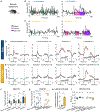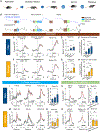Responses and functions of dopamine in nucleus accumbens core during social behaviors
- PMID: 36001967
- PMCID: PMC9511885
- DOI: 10.1016/j.celrep.2022.111246
Responses and functions of dopamine in nucleus accumbens core during social behaviors
Abstract
Social behaviors are among the most important motivated behaviors. How dopamine (DA), a "reward" signal, releases during social behaviors has been a topic of interest for decades. Here, we use a genetically encoded DA sensor, GRABDA2m, to record DA activity in the nucleus accumbens (NAc) core during various social behaviors in male and female mice. We find that DA releases during approach, investigation and consummation phases of social behaviors signal animals' motivation, familiarity of the social target, and valence of the experience, respectively. Positive and negative social experiences evoke opposite DA patterns. Furthermore, DA releases during mating and fighting are sexually dimorphic with a higher level in males than in females. At the functional level, increasing DA in NAc enhances social interest toward a familiar conspecific and alleviates defeat-induced social avoidance. Altogether, our results reveal complex information encoded by NAc DA activity during social behaviors and their multistage functional roles.
Keywords: CP: Neuroscience; dopamine; innate social behaviors; nucleus accumbens core; sex difference; social avoidance learning; social interest.
Copyright © 2022 The Author(s). Published by Elsevier Inc. All rights reserved.
Conflict of interest statement
Declaration of interests The authors declare no competing interests.
Figures







Similar articles
-
Differential Dopamine Release Dynamics in the Nucleus Accumbens Core and Shell Reveal Complementary Signals for Error Prediction and Incentive Motivation.J Neurosci. 2015 Aug 19;35(33):11572-82. doi: 10.1523/JNEUROSCI.2344-15.2015. J Neurosci. 2015. PMID: 26290234 Free PMC article.
-
Topography of Reward and Aversion Encoding in the Mesolimbic Dopaminergic System.J Neurosci. 2019 Aug 14;39(33):6472-6481. doi: 10.1523/JNEUROSCI.0271-19.2019. Epub 2019 Jun 19. J Neurosci. 2019. PMID: 31217328 Free PMC article.
-
The role of nucleus accumbens dopamine in motivated behavior: a unifying interpretation with special reference to reward-seeking.Brain Res Brain Res Rev. 1999 Dec;31(1):6-41. doi: 10.1016/s0165-0173(99)00023-5. Brain Res Brain Res Rev. 1999. PMID: 10611493 Review.
-
Chronic Augmentation of Endocannabinoid Levels Persistently Increases Dopaminergic Encoding of Reward Cost and Motivation.J Neurosci. 2021 Aug 11;41(32):6946-6953. doi: 10.1523/JNEUROSCI.0285-21.2021. Epub 2021 Jul 6. J Neurosci. 2021. PMID: 34230105 Free PMC article.
-
A review of the effects of different types of social behaviors on the recruitment of neuropeptides and neurotransmitters in the nucleus accumbens.Front Neuroendocrinol. 2025 Apr;77:101175. doi: 10.1016/j.yfrne.2025.101175. Epub 2025 Jan 31. Front Neuroendocrinol. 2025. PMID: 39892577 Review.
Cited by
-
Dopamine control of social novelty preference is constrained by an interpeduncular-tegmentum circuit.Nat Commun. 2024 Apr 3;15(1):2891. doi: 10.1038/s41467-024-47255-y. Nat Commun. 2024. PMID: 38570514 Free PMC article.
-
Different Effects of Peer Sex on Operant Responding for Social Interaction and Striatal Dopamine Activity.J Neurosci. 2024 Mar 6;44(10):e1887232024. doi: 10.1523/JNEUROSCI.1887-23.2024. J Neurosci. 2024. PMID: 38346894 Free PMC article.
-
Distinct subcircuits within the mesolimbic dopamine system encode the salience and valence of social stimuli.bioRxiv [Preprint]. 2024 Jul 24:2024.07.23.604824. doi: 10.1101/2024.07.23.604824. bioRxiv. 2024. Update in: Psychopharmacology (Berl). 2025 Apr 18. doi: 10.1007/s00213-025-06793-z. PMID: 39091886 Free PMC article. Updated. Preprint.
-
Detection, processing and reinforcement of social cues: regulation by the oxytocin system.Nat Rev Neurosci. 2023 Dec;24(12):761-777. doi: 10.1038/s41583-023-00759-w. Epub 2023 Oct 27. Nat Rev Neurosci. 2023. PMID: 37891399 Review.
-
Serotonin neurons in mating female mice are activated by male ejaculation.Curr Biol. 2023 Nov 20;33(22):4926-4936.e4. doi: 10.1016/j.cub.2023.09.071. Epub 2023 Oct 20. Curr Biol. 2023. PMID: 37865094 Free PMC article.
References
-
- Afonso VM, Grella SL, Chatterjee D, and Fleming AS (2008). Previous maternal experience affects accumbal dopaminergic responses to pup-stimuli. Brain Res. 1198, 115–123. - PubMed
-
- Afonso VM, King S, Chatterjee D, and Fleming AS (2009). Hormones that increase maternal responsiveness affect accumbal dopaminergic responses to pup-and food-stimuli in the female rat. Horm. Behav 56, 11–23. - PubMed
Publication types
MeSH terms
Substances
Grants and funding
LinkOut - more resources
Full Text Sources
Molecular Biology Databases
Research Materials
Miscellaneous

